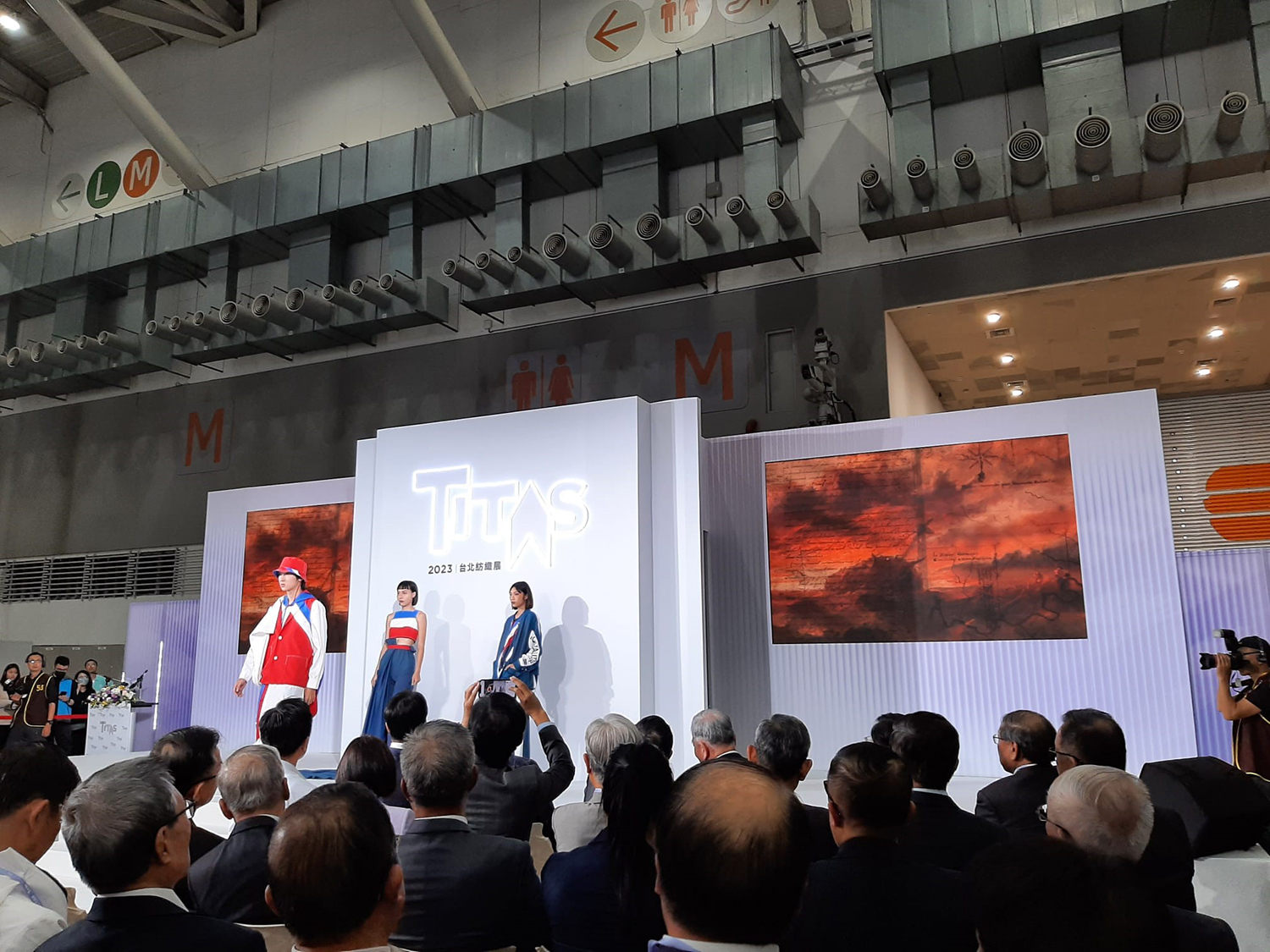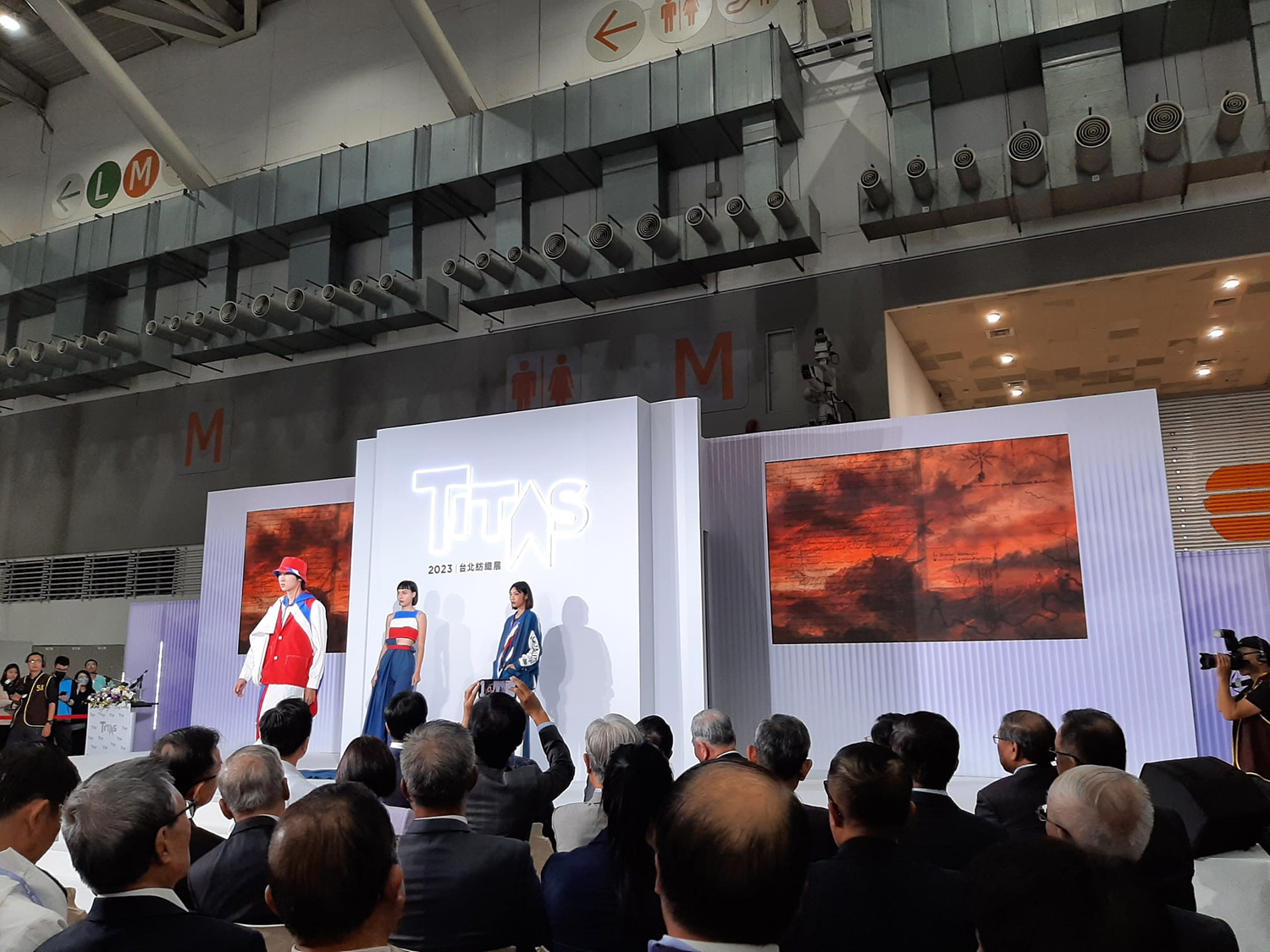
The 27th Taipei Innovative Textile Application Show (TITAS) came to a successful close at Taiwan’s Nangang Exhibition Centre on 19 October 2023. The event attracted 381 exhibitors from 11 countries who showcased key innovations in critical trend areas across the textile value chain to promote the green transformation of the industry.
Taiwan’s textile industry ranks first in the world in terms of functional and green fabrics and stakeholders are continuously transforming, upgrading and actively engaging in innovative R&D. TITAS is Asia’s key sourcing platform for textiles and clothing and participation in the event continues to rise.
The number of exhibitors in 2023 increased by 3.8% from 2022, and there were 6% more booths this year. A total of 35,000 visitors from the US, Canada, the UK, Germany, Italy, Spain, Netherlands, Norway, Sweden, South Africa, Australia, New Zealand, Japan, South Korea and Bangladesh networked with 381 exhibitors across 952 booths during the three-day exhibition period. Future business opportunities generated by the event are estimated to be approximately US$47m, according to the organisers, the Taiwan Textile Federation (TTF) in partnership with the International Trade Administration (ITA) of the Ministry of Economic Affairs (MOEA).
James Wilson, sales development manager at the World Textile Information Network (WTiN) and long-time visitor to TITAS, said the event “never fails to disappoint”. Having not been to the event for the last four years due to the Covid-19 pandemic, Wilson said: “TITAS and Taiwan-based companies in the industry seem to have an in-built DNA that allows them to continually reinvent themselves to stay at the forefront of innovation in functionality in textiles & apparel.
“The show was very busy, vibrant and dynamic. I was surprised at how young all the visitors and exhibitors were. With the global textile industry suffering from an ageing workforce and a burgeoning skills gap, it shows young people in the region are engaged with the textile sector, meaning Taiwan’s textile industry will remain healthy for years to come.”
He added that the partnership between the Taiwan Textile Federation, organisers of TITAS, have a unique synergy with the Taiwan Textile Research Institute (TTRI) and business within industry that fosters collaboration within the market, leading to successful R&D and implementation.
Taiwan Textile Federation (TTF) chairman Kuo highlighted that climate change is becoming an increasingly severe challenge to business operations and achieving sustainable development has become the concern of the global textile industry. He said Taiwan’s textile industry was investing considerable resources and efforts in decarbonisation and sustainability, which made it a reliable partner for global brands who were trying to achieve net zero.
To keep its finger on the pulse of the global market, TITAS focused on the three core themes of “Sustainability, Functional Applications, and Intelligent Manufacturing” to showcase the achievements of Taiwan’s textile industry in innovation and sustainability.
Innovations in sustainability
Green textiles were at the forefront of the exhibits at TITAS 2023. Driven by the net-zero wave in the global supply chain, textile companies are actively transforming their businesses into low-carbon operations. Building a green supply chain is critical for companies developing sustainable credentials. As leading brands such as Nike, Adidas and Lululemon (to name but a few) set net-zero carbon reduction goals, Taiwan’s textile industry – which plays an important role in the global value chain – is actively building a functional and green supply chain to cater for buyers’ needs.
Exhibitors saw examples of innovative technology that had been devised to promote the sustainable development of functional textiles. There was a wealth of cutting-edge solutions for environmentally friendly recycling – including repurposing agricultural waste to make yarn from cocoa and pineapple fibre; making biofibres from non-edible corn, sucrose, castor oil and other plants; and using recycled tyres to make regenerated nylon. Other new technology on show included new methods of turning recycled clothing and fabric scraps into raw materials and making regenerated nylon fibre from waste fishing nets and oyster ropes. There were also examples of waterless dyeing and low-temperature dyeing, which had been designed to reduce wastewater and energy consumption.
New technologies on show included FENC®TOPGREEN®’s BIO3 fabric, which incorporates the concept of green fashion into product design and has received the prestigious Red Dot Design Award. Meanwhile, Formosa Chemicals & Fibre (FCFC)was showcasing the expansion of its recycled nylon from waste marine fishing nets to clothing applications in athleisure wear and footwear. Formosa Taffeta has launched bio-plastic elastic yarn, which transforms non-edible industrial corn into biomass materials through fermentation technology. Exhibitor LIBOLON showcased its green circulation concept with a “water circular economy”, while Yi Shin was promoting its Magic Recycle-WTG (waste to goods), which is composed of Global Recycled Standard-certified recycled yarn made from pre-consumer textile waste and post-consumer plastic bottles. Zig Sheng showcased its Bluecircle yarn, a 100% textile recycled yarn, and N66 Soufflex, a low fibre-shedding and stretchy yarn.
The benefits of collaboration were evident at the show, such as Shinkong Synthetic Fiber’s Cycora® recycled fabrics, which are the result of a waste regeneration partnership f between Shinkong and Ambercycle. GrandeTex’s Secao® yarn is the result of its collaboration with the Agricultural Technology Research Institute (ATRI).
TITAS exhibitors emphasised functional considerations in comfort, health, leisure, sports, safety, protection and medical care, including water-based waterproof and breathable membranes, high-efficiency deodorising polyester fibres, functional graphene, etc. For example, Eclat has developed a revolutionary, inherently soft material called Softform, which serves as a green alternative to peached materials. Tex-Ray’s Eco Trans patented technology is a high-resolution printing process developed for sustainable environmental protection. Nylon fibre manufacturer Chain Yarn demonstrated its commitment to innovation and development in nylon fibres. Grand Textile has obtained several patents including Stone Cold® (cooling technology), Coffee Charcoal® (thermal regulation), and Color Max (dyeing technique creating spray dye/tie dye effect). The SINGTEX® S.Café® eco2sy plus is made from coffee and recycled PET bottles and is designed to absorb undesired body odour. Everest showcased its biodegradable waterproof and breathable membranes, coupled with laminated products made from biodegradable fibres.
What’s more, to move towards green transformation and low-carbon production goals, textile machinery manufacturers were promoting Industry 4.0 technologies and automation, including data collection and analysis and artificial intelligence (AI). Specific solutions showcased at TITAS in line with this movement included RFID yarn, AI fabric inspection machines, automatic sampling looms, digital textile inkjet printers, a smart manufacturing data control centre and smart weaving, etc. For example: Pailung’s AlterKnit™ technology is said to revolutionise circular knitting, while New Wide adheres to the principles of “Reduce, Reuse and Recycle” in water resource utilisation. Its Intelligent Data Control Centre (IDCC) can optimise production schedules and address abnormalities, which is said to lead to a 20% increase in overall efficiency. Oshima also demonstrated its fabric-spreading machine, which has full real-time monitoring so manufacturing lines can be observed remotely.
Educational sessions
Industry experts shared their knowledge in a series of talks informing visitors about cutting-edge technology that can help businesses work more sustainably to meet the demands of upcoming legislation, from functional fibres and low-carbon yarns to innovations in recycling and supply chain transparency. There were also examples of how AI is transforming fabric development design and collaboration in business processes. The event hosted a fashion show, new product launches, and trend forecasts in the stage area. These nine seminars and five microevents were excellent platforms for conveying the latest knowledge, networking, and discovering industry market intelligence.
Connect with global brands
According to statistics from the organiser, the top 10 overseas visitor countries and regions were Japan, Hong Kong, South Korea, the US, Mainland China, Vietnam, India, Thailand, Malaysia and Germany. The number of overseas visitors increased by 281% since 2022. Brands in Europe and the US are anticipated to have achieved results in destocking and new product opportunities. TITAS invited more than 71 brands from 15 countries to attend the show and conducted more than 800 business meetings with 183 exhibitors. This season’s procurement focused on multifunctions of woven and knitted textiles that combine sports, outdoor leisure, fashion, and home textiles. These sought-after materials offer properties including moisture-wicking, waterproof and moisture-permeability, anti-UV, far-infrared, insulation and temperature regulation, deodorisation, antibacterial, antifouling, high strength and wear resistance.
TITAS 2024 was held in the Nangang Exhibition Center Hall 1 from 15-17 October 2024. With the strong support of the ITA, MOEA and the industry, Taiwan will continue to dominate the global green and functional textile market.
Have your say. Tweet and follow us @WTiNcomment






